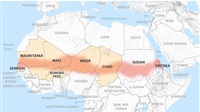Air pollution in China back to pre-Covid levels and Europe may follow

Air pollution in China has climbed back to pre-pandemic
levels, and scientists say Europe may follow suit.
Air pollution causes at least 8m early deaths a year, and
cleaner skies were seen as one of the few silver linings of Covid-19. Experts
have called for action to help retain the air quality benefits of lockdowns,
and measures taken to date have included expanding cycle lanes and space for
walking in cities.
Data from the Centre for Research on Energy and Clean Air
(Crea) shows concentrations of fine particles (PM2.5) and nitrogen dioxide
(NO2) across China are now at the same levels as one year earlier. At the
height of the country’s coronavirus response in early March, NO2 levels were
down by 38% from 2019 and levels of PM2.5 were down by 34%.
“The rapid rebound in air pollution and coal consumption
levels across China is an early warning of what a smokestack industry-led
rebound could look like,” said Crea’s lead analyst, Lauri Myllyvirta. “Highly
polluting industries have been faster to recover from the crisis than the rest
of the economy. It is essential for policymakers to prioritise clean energy.”
The energy consultancy group Wood Mackenzie predicts
China’s oil demand will recover to near normal levels in the second quarter of
2020.
In Wuhan, the city at the centre of the epidemic, NO2
levels are now just 14% lower than last year, having briefly dropped by almost
half. In Shanghai, the latest levels are 9% higher than last year.
European cities have also seen a big dip in air pollution
during the virus outbreak. Data from the Copernicus Atmosphere Monitoring
Service (Cams), which tracks pollution in 50 European cities, shows that 42 of
them recorded below-average levels of NO2 in March. London and Paris had 30%
reductions in NO2, a pollutant that is mostly produced by diesel vehicles.
“We do expect pollution to rebound, but we have not been
able yet to show that,” said Vincent-Henri Peuch, the director of Cams. He
noted that the Cams data showed average air pollution levels across cities.
“Next to a busy road, the effect of traffic reduction will be higher – up to
70% or 80% [reduced pollution] in places,” he said.
Distinguishing the pollution changes caused by the
lockdowns and their subsequent relaxations from other factors, such as weather
and chemical interaction of pollutants, is complex. Spring is the most polluted
season in western Europe in normal years, owing to the start of the agriculture
cycle which causes ammonia emissions that go on to form particles over cities.
The Cams team is now working with the Barcelona
Supercomputing Centre to untangle these factors and produce robust estimates of
the coronavirus effect.
Peuch said what happens next to air quality in European
cities remained to be seen. “We do not know how people’s behaviour will change,
for example avoiding public transport and therefore relying more on their own
cars, or continuing to work from home.”
Gary Fuller, an air pollution expert at Kings College
London, said: “Rather than let this time be forgotten, the United Nations and
environmental campaigners are urging governments to ‘build back better, to
invest in the future not the past’, to ensure that our global recovery has
sustainable legacy.”
Air pollution has been linked to heart and lung damage
and many other conditions including diabetes and damaged intelligence. It is
likely to affect virtually every organ in the body.
There is growing evidence linking exposure to dirty air
to increased risk of death from Covid-19, prompting calls to keep air pollution
low to help avoid the dangers of a second wave of infection.







